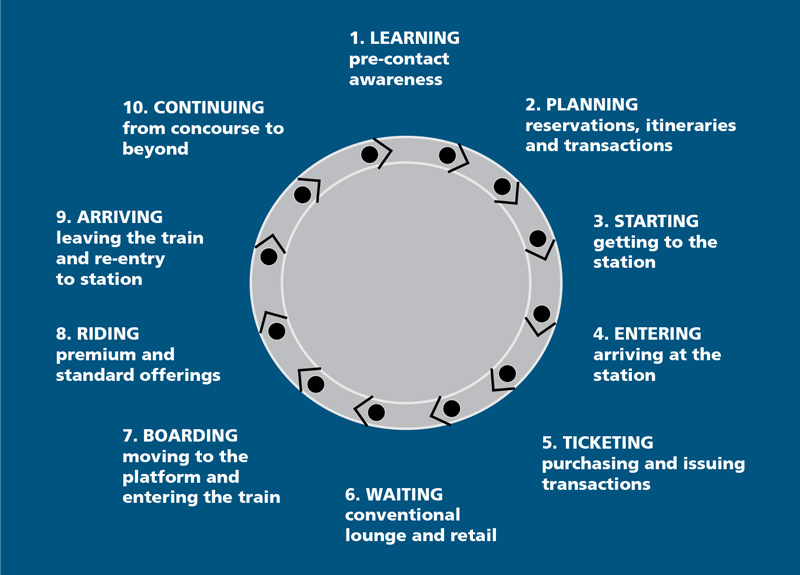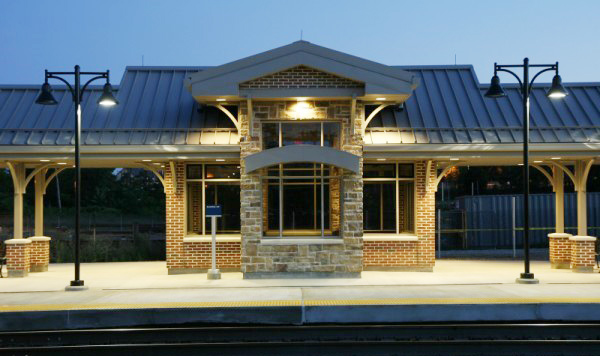Stations are a key factor in travelers’ perception of Amtrak and the towns we serve. Historically, stations have acted as the gateways to our communities, and many continue to occupy prominent downtown locations.
A station’s condition reflects on the station owner, community and Amtrak; therefore, it is in the best interest of these stakeholders to ensure stations are well-maintained and appropriately branded. Amtrak rail stations range from platform-only stations to large urban mixed-use transit centers. Each has unique design requirements, depending on the type of rail service provided.
Amtrak holds to the service philosophy of the Seamless Journey, which defines trip quality and modal choice relating to stations. Every passenger journey is defined by 10 factors that make up the Seamless Journey.

Amtrak Seamless Journey
Because the station represents a major portion of the travel experience, and most of the 10 steps in the Seamless Journey take place within the station, it is imperative to create an environment that is welcoming, functional and clean – one that will be memorable and will encourage customers to choose Amtrak again while also creating a civic focal point in the community.
Station Planning and Development Guidelines
Developed and refined over many years, the Amtrak Station Planning and Development Guidelines are meant to assist parties looking to understand the Amtrak station planning and development process, including communities interested in new Amtrak service, local and regional transit agencies, regional infrastructure planning professionals, real estate developers and existing station owners, as well as design professionals such as architects, planners and engineers.
The Guidelines provide design considerations and criteria to guide station planning, development and design, rather than simply listing standards or specifications.
The planning and design of a new station or a renovation to an existing station involves a number of complex issues that must be carefully coordinated. They include determining the ridership, funding, agreements, ownership, operations, programing, design, construction and implementation of the project. As your project develops, an Amtrak Facilities Development Manager will shepherd the team through the process and provide the design professional with Amtrak’s requirements, standards and specifications. Coordination with Amtrak during all phases of a station design project is key to its success.
The Amtrak Station Planning and Development Guidelines are are organized to facilitate the development and design process, and the document covers three parts:
- Development Process: Includes general planning and background information.
- Design Considerations: Includes design criteria, functional and program requirements for stations of all sizes and typologies.
- Appendices: Reference material and technical content addressing topics such as historic stations and building systems.

The station in Alliance, Ohio, is based on an Amtrak prototype for a shelter-type station.
Amtrak is available to support communities in the station design and development process. In addition to the Guidelines, Amtrak can provide:
- Prototype station designs,
- Engineering standards,
- Plan review and approval,
- Coordination with host railroads,
- Funding and grant support,
- Joint planning support, and
- General consultation.
If you have any questions about this document, please contact the Amtrak Station Planning group.
A special note to city/town officials, planners, architects and engineers working on a station project: even if your project is only in the visioning phase, please contact the Station Planning group to ensure Amtrak is aware of your proposal.


 We’re always looking for ways Amtrak can help with your station program. If you have feedback, or just find something here at Great American Stations useful, we’d love to hear from you.
We’re always looking for ways Amtrak can help with your station program. If you have feedback, or just find something here at Great American Stations useful, we’d love to hear from you. Amtrak established the Great American Stations Project in 2006 to educate communities on the benefits of redeveloping train stations, offer tools to community leaders to preserve their stations, and provide the appropriate Amtrak resources.
Amtrak established the Great American Stations Project in 2006 to educate communities on the benefits of redeveloping train stations, offer tools to community leaders to preserve their stations, and provide the appropriate Amtrak resources. For more than 50 years, Amtrak has connected America and modernized train travel. Offering a safe, environmentally efficient way to reach more than 500 destinations across 46 states and parts of Canada, Amtrak provides travelers with an experience that sets a new standard. Book travel, check train status, access your eTicket and more through the
For more than 50 years, Amtrak has connected America and modernized train travel. Offering a safe, environmentally efficient way to reach more than 500 destinations across 46 states and parts of Canada, Amtrak provides travelers with an experience that sets a new standard. Book travel, check train status, access your eTicket and more through the